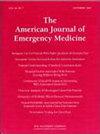天气、空气污染和病毒变异对急诊重症COVID-19急性呼吸衰竭的影响
IF 2.7
3区 医学
Q1 EMERGENCY MEDICINE
引用次数: 0
摘要
空气污染和气象因素被认为会增加患严重COVID-19的风险,但证据仍然存在争议。本研究旨在评估天气、空气污染和SARS-CoV-2变异对COVID-19合并急性呼吸衰竭(ARF)的影响,并探讨急诊科(ED)的呼吸管理。方法对2020年3月1日至2023年12月31日期间就诊的469例COVID-19急诊科患者进行前瞻性观察研究。空气污染水平和天气变量的数据来自台湾中央气象局(CWB)和环保局(EPA)。采用扩展双变量和多变量泊松回归模型的广义线性模型来估计天气变量、空气污染物、病毒变异与COVID-19 ARF患者之间的关联。结果469例患者中,男性占64%,平均年龄70±6岁。总体而言,18% (n = 84)的患者死亡,43% (n = 200)的患者插管,70% (n = 326)的患者入住ICU。我们观察到PM2.5、PM10、温度和风速与COVID-19合并ARF的急诊科就诊之间存在显著正相关。PM2.5、PM10每增加1 μg/m3,风速每增加1 m/s,气温每增加1℃,分别与新冠肺炎日平均发病人数增加34.1% (95% CI: 8.2% - 66.1%)、45.4% (95% CI: 39.4% - 46.6%)、19.0% (95% CI: 11.4% - 27.0%)和10.4% (95% CI: 6.9% - 13.9%)显著相关。相比之下,NO2、SO2、相对湿度和日照与COVID-19重症患者平均日人数降低显著相关。此外,病毒变异在湿度和日照之间呈显著正相关,分别为53.9% (95% CI: 37.0% ~ 70.3%)和5.4% (95% CI: 0.6% ~ 10.4%)。结论大气污染、气候变化、病毒变异与COVID-19之间的关系非常复杂。空气污染加剧了COVID-19的严重程度,气候变化影响病毒传播和人类免疫反应,病毒变异使大流行控制更具挑战性。这些相互作用对于未来的预测、预防和应对全球卫生危机至关重要。本文章由计算机程序翻译,如有差异,请以英文原文为准。
Impact of weather, air pollution and virus variant on COVID-19 with acute respiratory failure in the emergency department
Background
Air pollution and meteorological factors are thought to contribute to increased risk of severe COVID-19, but the evidence is still controversial. This study aimed to assess the effects of weather, air pollution and SARS-CoV-2 variants on COVID-19 with acute respiratory failure (ARF) and investigate the respiratory management in the emergency department (ED).
Methods
We conducted a prospective observational study of 469 COVID-19 ED visits from March 1, 2020 to December 31, 2023. Data on air pollutant levels and weather variables was obtained from Taiwan Central Weather Bureau (CWB) and Environmental Protection Administration (EPA). The generalized linear models extending bivariate and multivariable Poisson regression models were used to estimate the association between the weather variables, air pollutants, virus variants, and COVID-19 patients with ARF.
Results
Among the 469 patients, 64 % were male, and the mean age was 70 ± 6 years. Overall, 18 % (n = 84) of the cohort died, 43 % (n = 200) were intubated, and 70 % (n = 326) were admitted to the ICU. We observed significantly positive associations between PM2.5, PM10, temperature, and wind speed with ED visits for COVID-19 with ARF. Every 1 μg/m3 increase in PM2.5, PM10, each 1 m/s increase in wind speed, and 1 °C increase in temperature were significantly associated with a 34.1 % (95 % CI: 8.2 %–66.1 %), 45.4 % (95 % CI: 39.4 %–46.6 %), 19.0 % (95 % CI: 11.4 %–27.0 %), and 10.4 % (95 % CI: 6.9 %–13.9 %) increase in the average daily number of COVID-19 patients respectively. In contrast, NO2, SO2, relative humidity, and sunshine were significantly associated with lower average daily numbers of severe COVID-19 patients. Moreover, virus variants were significantly positive associations between humidity and sunshine, 53.9 % (95 % CI: 37.0 %–70.3 %) and 5.4 % (95 % CI: 0.6 %–10.4 %) respectively.
Conclusion
The relationship between air pollution, climate change, virus variants, and COVID-19 is highly intricate. Air pollution exacerbates the severity of COVID-19, climate change influences virus transmission and human immune responses, and viral variants make pandemic control more challenging. These interactions are critical for future prediction, prevention and responses to global health crises.
求助全文
通过发布文献求助,成功后即可免费获取论文全文。
去求助
来源期刊
CiteScore
6.00
自引率
5.60%
发文量
730
审稿时长
42 days
期刊介绍:
A distinctive blend of practicality and scholarliness makes the American Journal of Emergency Medicine a key source for information on emergency medical care. Covering all activities concerned with emergency medicine, it is the journal to turn to for information to help increase the ability to understand, recognize and treat emergency conditions. Issues contain clinical articles, case reports, review articles, editorials, international notes, book reviews and more.

 求助内容:
求助内容: 应助结果提醒方式:
应助结果提醒方式:


